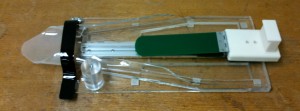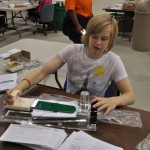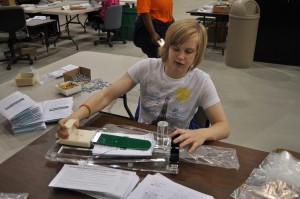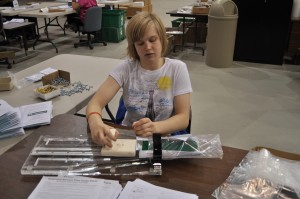Designers: Akshay Ahuja, Matthew Bostian, Katy Millay, and David Skwerer
Client Coordinator: Gena Brown, Goodwill Industries
[youtube]http://www.youtube.com/watch?v=rWmpEDUAOPI[/youtube]
INTRODUCTION
Goodwill Industries is a non-profit organization that offers specialized job training and placement services for people with disabilities. They have a longstanding contract with a company that produces timecard-punching machines. For this contract, one of the tasks is to package user manuals, timecards, keys, and hardware into small Ziploc bags, which are then boxed and sold with the machines. This is a challenging task because of the small size of the bags, which are barely large enough to fit the enclosed items. Our client, “Cindy,” has Cerebral Palsy and has trouble controlling the shaking and spasticity in her hands. It is difficult for her to handle and package these items independently. Furthermore, Cindy uses her dominant hand while working and has trouble controlling her opposite, non-dominant hand, which can hinder her efforts.
The objective of this project was to design and manufacture an assistive device that will enable the client to perform the bag filling task with one hand. This device should enable our client to easily, neatly, efficiently, and independently insert the materials into the Ziploc bags. It should be durable, portable, and accessible for use by a number of Goodwill employees with other disabilities.

Figure 1: The Time Card Packaging System: the client slides the bag onto the funnel on the left side, and places the papers on the loading platform in the middle. The green acrylic flap is on a hinge, and the client flips it town on top of the papers before sliding them into the bag.
SUMMARY OF IMACT
With the Time Card Packaging System, Cindy can insert time cards and pamphlets into a Ziploc bag within the desired industry standard time period. This device will have an enormous impact on Cindy’s efficiency and versatility in the workplace. One of the Goodwill staff members, Jeff Fleming, stated that, “on the work floor we have only a few jobs that this client is able to perform, and though she can do these jobs she does not complete them in a timely manner (the minimum time standard). With this device she can not only do another job, but she can perform the job within the minimum time period.”
TECHNICAL DESCRIPTION
There are two important steps to this task: holding the papers together, and sliding the papers inside an open Ziploc bag. The device that we designed consists of (a) a funnel-shaped piece of acrylic; (b) a linear guide block that glides along a rail below it; (c) a Ziploc bag securing mechanism; and (d) a hand stabilization bar. In order to perform the task, Cindy pushes a Ziploc bag over the funneled end of the acrylic, secures it in place, and then drops her stacked materials onto the loading platform directly in front of the guide block. Next, using the guide block, which is attached to the rail, she slides the papers into the tapered, funneled section of the acrylic. At this point, the edges of the papers begin to curl, temporarily reducing their width and allowing them to easily slide into the opened Ziploc bag. Once out of the funnel and inside the bag, the papers will return to their full, original width. The filled bag is then removed and replaced by another empty one, allowing Cindy to perform her tasks in quick succession.
Funnel and base
The funnel and base were made of acrylic and cut with a laser cutter to the proper shape. Using a heat gun, we warmed the acrylic until it was soft and malleable. We then bent it around a prefabricated mold in order to achieve the desired funnel shape. We used a solvent, methylene chloride, to fuse all of the acrylic pieces together into one solid unit. Our manufacturing process ensured that the funnel surface was free of scratches, bumps, cracks, etc., to reduce friction and allow smooth and unhindered transfer of the papers into the Ziploc bags.
Sliding rail and guide block
We mounted an anodized aluminum guide rail onto the base of the device. We used a zinc-chromate steel guide block with a self-lubricating PTFE liner to slide along the rail. Attached to the top of this guide block is a plastic pusher, made using a Fusion Deposition Modeling (FDM) system, designed to be ergonomic by offering the user multiple gripping options. There is an acrylic loading platform attached to the front of the guide block, and a hinged acrylic flap that the client lowers on top of the papers. Because the papers are sandwiched between these two layers of acrylic, they stay organized as the client pushes them through the funnel.
Ziploc bag securing mechanism
We created a securing mechanism to prevent the Ziploc bags from slipping off the end of the funneled acrylic while the materials are being loaded. This simple yet effective mechanism, which acts like seatbelt for the bags, consists of a thin strip of molded acrylic, self-adhesive foam padding and Velcro. To secure a Ziploc bag on the end of the funnel, the clients flips the acrylic strip across the bag and funnel, and attaches it to the opposite corner of the base with Velcro. When finished, Cindy can simply release the Velcro connection to remove the bag and packaged materials.
Hand stabilization bar
Cindy has trouble controlling her non-dominant, unoccupied hand; this can hinder her work efforts and slow her overall progress. Our device employs a hand stabilization bar to occupy her non-dominant hand while she performs the task. The bar was manufactured from a 1-3⁄4” diameter acrylic dowel rod. This gives her more control over her movements as well as a counter-force while she is loading the materials into the Ziploc bags.
The total cost of this device was $100.




University Operator: (919) 962-2211 | © 2024 The University of North Carolina at Chapel Hill |